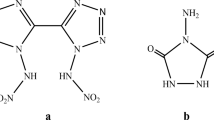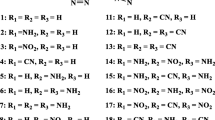Abstract
To design novel phenanthroline-derived soft ligands for selectively separating minor actinides from lanthanides, four tetradentate phenanthroline-derived heterocyclic ligands (BTPhen, BPyPhen, BPzPhen, and BBizPhen) were constructed and their complexation behaviors with Am(III) and Eu(III) were systematically investigated by density functional theory (DFT) coupled with relativistic small-core pseudopotential. In all the 1:1-type species, the metal ion is in the center of the cavity and coordinates with two nitrogen atoms (N1 and N1′) of the phenanthroline skeleton and the other two nitrogen atoms (N2 and N2′) of the auxiliary groups. The bond lengths of Am-N are comparable to or even shorter than those of Eu-N bonds because the ionic radii of Am(III) are larger than those of Eu(III). Additionally, the negative ΔΔG Am/Eu value for the reaction of [M(H2O)4(NO3)3] + L → ML(NO3)3 + 4H2O indicates that the complexation reaction of Am(III) is more energetically favorable than that of Eu(III); this can be considered as an important design criterion to screen phenanthroline-derived ligands for MA(III) extraction. According to this criterion, the selectivity of tetradentate phenanthroline-derived ligands for separating Am(III) over Eu(III) follows the order of BTPhen > BBizPhen > BPyPhen > BPzPhen.
Similar content being viewed by others
References
Panak PJ, Geist A. Complexation and extraction of trivalent actinides and lanthanides by triazinylpyridine N-donor ligands. Chem Rev, 2013, 113: 1199–1236
Hudson MJ, Harwood LM, Laventine DM, Lewis FW. Use of soft heterocyclic N-donor ligands to separate actinides and lanthanides. Inorg Chem, 2013, 52: 3414–3428
Hancock RD. The pyridyl group in ligand design for selective metal ion complexation and sensing. Chem Soc Rev, 2013, 42: 1500–1524
Modolo G, Wilden A, Geist A, Magnusson D, Malmbeck R. A review of the demonstration of innovative solvent extraction processes for the recovery of trivalent minor actinides from PUREX raffinate. Radiochim Acta, 2012, 100: 715–725
Lan JH, Shi WQ, Yuan LY, Li J, Zhao YL, Chai ZF. Recent advances in computational modeling and simulations on the An(III)/Ln(III) separation process. Coord Chem Rev, 2012, 256: 1406–417
Cao X, Heidelberg D, Ciupka J, Dolg M. First-principles study of the separation of Am(III)/Cm(III) from Eu(III) with Cyanex 301. Inorg Chem, 2010, 49: 10307–10315
Kolarik Z. Complexation and separation of lanthanides(III) and actinides(III) by heterocyclic N-donors in solutions. Chem Rev, 2008, 108: 4208–4252
Chen J, Zhu YJ, Jiao RZ. The separation of Am from lanthanides by purified Cyanex 301 extraction. Sep Sci Technol, 1996, 31: 2723–2731
Nash KL, Choppin GR. Separations chemistry for actinide elements: recent developments and historical perspective. Sep Sci Technol, 1997, 32: 255–274
Kolarik Z, Mullich U, Gassner F. Extraction of Am(III) and Eu(III) nitrates by 2,6-di-(5,6-dipropyl-1,2,4-triazin-3-yl)pyridines. Solv Extr Ion Exch, 1999, 17: 1155–1170
Kolarik Z, Mullich U, Gassner F. Selective extraction of Am(III) over Eu(III) by 2,6-ditriazolyl- and 2,6-ditriazinylpyridines. Solv Extr Ion Exch, 1999, 17: 23–32
Trumm S, Geist A, Panak PJ, Fanghänel T. An improved hydrolytically-stable bis-triazinyl-pyridine (BTP) for selective actinide extraction. Solv Extr Ion Exch, 2011, 29: 213–229
Usuda S, Wei YZ, Liu RQ, Li Z, Xu YL, Wu Y, Kim S. Challenges to develop single-column MA(III) separation from HLLW using R-BTP type adsorbents. Sci China Chem, 2012, 55: 1732–1738
Wei YZ, Wang XP, Liu RQ, Wu Y, Usuda S, Arai T. An advanced partitioning process for key elements separation from high level liquid waste. Sci China Chem, 2012, 55: 1726–1731
Banik NL, Denecke MA, Geist A, Modolo G, Panak PJ, Rothe J. 2,6-Bis(5,6-dipropyl-1,2,4-triazin-3-yl)-pyridine: structures of An(III) and Ln(III) 1:3 complexes and selectivity. Inorg Chem Commun, 2013, 29: 172–174
Foreman MRS, Hudson MJ, Drew MGB, Hill C, Madic C. Complexes formed between the quadridentate, heterocyclic molecules 6,6′-bis-(5,6-dialkyl-1,2,4-triazin-3-yl)-2,2′-bipyridine (BTBP) and lanthanides(III): implications for the partitioning of actinides(III) and lanthanides(III). Dalton Trans, 2006: 1645–1653
Lan JH, Shi WQ, Yuan LY, Zhao YL, Chai ZF. Trivalent actinide and lanthanide separations by tetradentate nitrogen ligands: a quantum chemistry study. Inorg Chem, 2011, 50: 9230–9237
Lan JH, Shi WQ, Yuan LY, Feng YX, Zhao YL, Chai ZF. Thermo-dynamic study on the complexation of Am(III) and Eu(III) with tetradentate nitrogen ligands: a probe of complex species and reactions in aqueous solution. J Phys Chem A, 2012, 116: 504–511
Lewis FW, Harwood LM, Hudson MJ, Drew MGB, Wilden A, Sypula M, Modolo G, Vu TH, Simonin JP, Vidick G, Bousliman N, Desreux JF. From BTBPs to BTPhens: the effect of ligand preorganization on the extraction properties of quadridentate bis-triazine ligands. Procedia Chem, 2012, 7: 231–238
Lewis FW, Harwood LM, Krasnov VP. Synthesis and evaluation of lipophilic BTBP ligands for An/Ln separation in nuclear waste treatment: the effect of alkyl substitution on extraction properties and implications for ligand design. Eur J Org Chem, 2012: 1509–1519
Narbutt J, Oziminski WP. Selectivity of bis-triazinyl bipyridine ligands for americium(III) in Am/Eu separation by solvent extraction. Part 1. Quantum mechanical study on the structures of BTBP complexes and on the energy of the separation. Dalton Trans, 2012, 41: 14416–14424
Lewis FW, Harwood LM, Hudson MJ, Drew MGB, Hubscher-Bruder V, Videva V, Arnaud-Neu F, Stamberg K, Vyas S. BTBPs versus BTPhens: some reasons for their differences in properties concerning the partitioning of minor actinides and the advantages of BTPhens. Inorg Chem, 2013, 52: 4993–5005
Lewis FW, Harwood LM, Hudson MJ, Drew MGB, Desreux JF, Vidick G, Bouslimani N, Modolo G, Wilden A, Sypula M, Vu TH II, Simonin JP II. Highly efficient separation of actinides from lanthanides by a phenanthroline-derived bis-triazine ligand. J Am Chem Soc, 2011, 133: 13093–13102
Lewis FW, Hudson MJ, Harwood LM. Development of highly selective ligands for separations of actinides from lanthanides in the nuclear fuel cycle. Synlett, 2011: 2609–2632
Whittaker DM, Griffiths TL, Helliwell M, Swinburne AN, Natrajan LS, Lewis FW, Harwood LM, SA II, Sharrad GA. Lanthanide speciation in potential sanex and GANEX actinide/lanthanide separations using tetra-N-donor extractants. Inorg Chem, 2013, 52: 3429–3444
Benay G, Schurhammer R, Wipff G. Basicity, complexation ability and interfacial behavior of BTBPs: a simulation study. Phys Chem Chem Phys, 2011, 13: 2922–2934
Frisch MJ, Trucks GW, Schlegel HB. Gaussian 09, Revision A.1. Wallingford CT: Gaussian, Inc., 2009
Becke AD. Density-functional exchange-energy approximation with correct asymptotic-behavior. Phys Rev A, 1988, 38: 3098–3100
Lee CT, Yang WT, Parr RG. Development of the colle-salvetti correlation-energy formula into a functional of the electron-density. Phys Rev B, 1988, 37: 785–789
Dolg M, Stoll H, Preuss H. Energy-adjusted abinitio pseudopotentials for the rare-earth elements. J Chem Phys, 1989, 90: 1730–1734
Kuchle W, Dolg M, Stoll H, Preuss H. Energy-adjusted pseudopotentials for the actinides-parameter sets and test calculations for thorium and thorium monoxide. J Chem Phys, 1994, 100: 7535–7542
Carpenter JE, Weinhold F. Analysis of the geometry of the hydroxymethyl radical by the different hybrids for different spins natural bond orbital procedure. J Mol Struc-Theochem, 1988, 46: 41–62
Reed AE, Curtiss LA, Weinhold F. Intermolecular interactions from a natural bond orbital, donor-acceptor viewpoint. Chem Rev, 1988, 88: 899–926
Wang CZ, Lan JH, Zhao YL, Chai ZF, Wei YZ, Shi WQ. Density functional theory studies of UO2 2+ and NpO2 + complexes with carbamoylmethylphosphine oxide ligands. Inorg Chem, 2013, 52: 196–203
Wang CZ, Shi WQ, Lan JH, Zhao YL, Wei YZ, Chai ZF. Complexation behavior of Eu(III) and Am(III) with CMPO and Ph2CMPO ligands: insights from density functional theory. Inorg Chem, 2013, 52: 10904–10911
Xiao CL, Wang CZ, Yuan LY, Li B, He H, Wang SA, Zhao YL, Chai ZF, Shi WQ. Excellent selectivity for actinides with a tetradentate 2,9-diamide-1,10-phenanthroline ligand in highly acidic solution: a hard-soft donor combined strategy. Inorg Chem, 2014, 53: 1712–1720
Carolan AN, Cockrell GM, Williams NJ, Zhang G, VanDerveer DG, Lee HS, Thummel RP, Hancock RD. Selectivity of the highly preorganized tetradentate ligand 2,9-di(pyrid-2-yl)-1,10-phenanthroline for metal ions in aqueous solution, including lanthanide(III) ions and the uranyl(VI) cation. Inorg Chem, 2013, 52: 15–27
Zhang G, Zong R, Tseng HW, Thummel RP. Ru(II) complexes of tetradentate ligands related to 2,9-di(pyrid-2′-yl)-1, 10-phenanthroline. Inorg Chem, 2008, 47: 990–998
Bremer A, Ruff CM, Girnt D, Mullich U, Rothe J, Roesky PW, Panak PJ, Karpov A, Muller TJJ, Denecke MA, Geist A. 2,6-Bis(5-(2, 2-dimethylpropyl)-1H-pyrazol-3-yl)pyridine as a ligand for efficient actinide(III)/lanthanide(III) separation. Inorg Chem, 2012, 51: 5199–5207
Shannon RD. Revised effective ionic-radii and systematic studies of interatomic distances in halides and chalcogenides. Acta Crystallogr A, 1976, 32: 751–767
Author information
Authors and Affiliations
Corresponding author
Rights and permissions
About this article
Cite this article
Xiao, C., Wu, Q., Wang, C. et al. Design criteria for tetradentate phenanthroline-derived heterocyclic ligands to separate Am(III) from Eu(III). Sci. China Chem. 57, 1439–1448 (2014). https://doi.org/10.1007/s11426-014-5215-7
Received:
Accepted:
Published:
Issue Date:
DOI: https://doi.org/10.1007/s11426-014-5215-7




